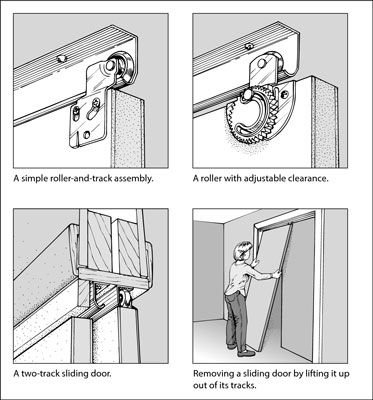
Maintaining bifold and sliding door tracks isn’t just about avoiding those annoying jams. It’s also about prolonging the life of your doors and enhancing their functionality. After all, a smooth door operation can make your home feel more welcoming. So, let’s take a look at some effective maintenance tips to keep those tracks in tip-top shape.
Understanding Bifold and Sliding Door Tracks
Before diving into maintenance, it’s helpful to know a bit about the mechanics of bifold and sliding door tracks. Bifold doors usually consist of two or more panels that fold along a track, while sliding doors operate with a single or double panel that slides horizontally. Their tracks can accumulate dirt, dust, and debris over time, causing friction and blocking smooth movement.
When you ignore the maintenance of these tracks, you might end up facing some serious problems. Doors can become hard to open, leading to potential misalignment or even damage. So, a quick clean now can prevent costly repairs later. Remember, prevention is always easier than fixing!
Regular Cleaning: The First Step
Cleaning your bifold and sliding door tracks should be your first line of defense. Honestly, this should be a part of your regular cleaning routine, just like dusting or vacuuming.
Here’s how to do it effectively:
- Gather Your Supplies: You’ll need a vacuum cleaner with a narrow attachment, a soft-bristled brush, a cloth, and a mild detergent.
- Vacuum First: Use the narrow attachment to suck out any loose dirt and debris. This prevents scrubbing dirt further into the tracks.
- Scrub Gently: Mix some mild detergent in warm water. Dip the brush into the solution and gently scrub the tracks. Rinse with water and wipe dry.
Doing this once a month will help keep dirt at bay. Plus, a clean track means smoother operation. You might even notice a difference the first time you slide that door open!
Inspecting for Damage
Cleaning is important, but it doesn’t stop there. Regularly inspecting your tracks ensures you catch potential issues before they escalate. Here’s what to look for:
- Check for Obstructions: Look for any debris or misplaced items that could be blocking the track.
- Examine the Track Surface: Look for wear and tear, like scratches or dents, that could affect the sliding mechanism.
- Test the Wheels: Make sure the wheels are moving freely. If they’re stuck or damaged, it might be time to replace them.
Remember, a little extra attention goes a long way in keeping your doors functional. Plus, checking for damage helps you avoid bigger issues down the road.
Lubrication: Keep It Smooth
Just like an engine runs better with oil, your door tracks need lubrication for optimal performance. You might be wondering how often you should lubricate. A good rule of thumb is every six months or whenever you notice resistance while opening or closing the doors.
Here’s how to do it:
- Choose the Right Lubricant: Use a silicone-based lubricant or a dry lubricant. Avoid greasy substances that can attract dirt.
- Apply Carefully: Spray or apply a small amount directly onto the track and wheels. You don’t need much—just a light coat will do.
- Wipe Off Excess: Too much lubricant can create a mess. Wipe off any excess to ensure a clean operation.
Regular lubrication helps not just with smoothness but also prevents rust and other damages over time.
Addressing Common Issues
Sometimes, despite your best efforts, problems can still arise. Here are a few common issues you might face and how to tackle them:
- Sticking Doors: If your doors are sticking, it might be due to dirt buildup or misalignment. Start with cleaning the tracks and checking the alignment.
- Noise: Squeaking or grinding sounds can indicate a need for lubrication or that something is blocked in the track.
- Misalignment: If your doors aren’t closing properly, check the alignment of both the track and the door. You may need to make adjustments or call a professional.
If things seem too complex, don’t hesitate to ask for help. Sometimes, it’s better to call in a pro than trying to fix a potential major issue yourself.
Seasonal Maintenance Tips
Different seasons can affect your doors and tracks. Here’s a quick guide based on the weather:
- Spring and Summer: These warmer months are great for cleaning and lubricating. However, pollen can clog tracks, so be diligent about cleaning.
- Fall: As leaves start to fall, ensure you clean up any debris that can accumulate in the tracks.
- Winter: Watch out for ice and snow, which can freeze the tracks. Make sure the area around the door is kept clear.
Seasonal maintenance helps you stay on top of any issues that may arise from changing weather conditions.
When to Call a Professional
Sometimes, despite all your efforts, things may not improve. If you find that your bifold or sliding doors are still troublesome after trying these maintenance tips, it might be time to call a professional. They can help with adjusting tracks, replacing wheels, or diagnosing larger issues.
Finding a competent service can save you headaches in the long run. Plus, knowing that experts are handling it can provide peace of mind.
In conclusion, maintaining your bifold and sliding door tracks is essential for smooth operation and longevity. By integrating simple tasks like cleaning, lubrication, and regular inspections into your routine, you can help prevent many common issues. It doesn’t take much time, and the benefits far outweigh the little effort you’ll need to put in. So, grab those cleaning supplies today, and give your door tracks the care they deserve!